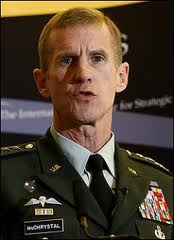By Michael O'Loughlin
America Magazine
July 27, 2010
http://www.americamagazine.org/blog/entry.cfm?blog_id=2&entry_id=3142
 |
In many respects, the U.S. Army and the Catholic Church could not be more dissimilar institutions. Both have radically different missions, divergent access to resources, and, seemingly, heterogeneous cultures. Yet in one striking way, the two organizations are quite analogous: both rely on and thrive under strict adherence to hierarchal rule. Despite the best efforts of some, especially during Vatican II, to move the church away from a pyramid model (pope at the top, then bishops, priests, religious, and finally laypeople) toward a flat “people of God” model, the church, for good or bad, remains thoroughly hierarchal, in both theory and in practice. The U.S. Army operates, out of necessity, in the same manner. As a result, recent events involving General Stanley McChrystal offer the church a valuable lesson and possible model to emulate.
McChrystal is regarded a dedicated, skilled, and devoted leader, who understands the intricacies of war and the sensitivities of .U.S presence in Afghanistan. His colleagues and superiors praise him continuously as a fair-minded military man, compelling others toward valiant and courageous service. Yet a couple months ago, McChrystal made an egregious mistake for anyone serving in a hierarchal institution: he upset the chain of command by calling into question the judgment of his superiors, specifically, the president and vice president. In the military, this is a mortal sin, and it cost the general his job.
At a ceremony marking his retirement on Friday in Washington, McChrystal made a simple and obvious observation to a crowd of 500 friends, family, and colleagues: “My service did not end as I would have wished.” Yet despite his less than graceful exit, many military hotshots were on hand to praise McChrystal’s years of service to his country. Secretary of Defense Robert Gates said: “We bid farewell to Stan McChrystal today with pride and sadness. Pride for the remarkable roster of achievement that he has compiled as a man and a soldier, sadness that our comrade and his prodigious talents are leaving us.” It was a ceremony marked with laughter, gratitude, and an exhortation for others to continue serving with dedication. Even the man who accepted McChrystal’s resignation, President Barack Obama, honored the general’s service by allowing him to retire with four stars even though he could have pushed for a lower rank, thereby reducing his pension and his prestige.
What can the church learn from McChrystal’s departure? McChrystal was a talented and devoted servant of his institution, but he erred gravely, and he then had to step aside so as to let the mission continue unencumbered by scandal and questions of his ability to lead. In the wake of his resignation, he was not attacked personally, thrown to the curb, and destroyed, but praised for his leadership even while standing in the searing light of accountability.
I can’t help but to think of our bishops during the sex abuse scandals (I realize the parallel is a bit flawed; some bishops are seemingly guilty of near criminal activity while McChrystal is not). Many of these men are pastoral, effective, and caring servants who exercised shockingly poor judgment when it came to transferring priests guilty of abuse. Had they possessed the courage to resign, they could have been praised by their subordinates and their flocks for their work in other areas, while recognizing that their continued leadership harmed the church and its lofty mission. These men are not evil, but by their decisions they showed quite clearly that they were not up to the heavy demands of their office. Another difference between the church and the Army, it appears, is that those above these bishops on the chain of command lacked the willingness or the ability to demand resignations. As a result, many of these men remain in office, and the church suffers. These bishops had the opportunity to step aside, have their accomplishments celebrated, and allow for healing and forgiveness to take over. They chose instead another path.
The closest example the church offers to this model is the resignation of Boston’s Cardinal Bernard Law. The epicenter of the scandal in the U.S., Boston paradoxically both thrived and suffered greatly under his leadership. After much external pressure, and presumably with some internal force as well, Law finally retired and moved to Rome. Despite the justified anger at Law during his resignation, many still recalled, albeit more guardedly than with McChrystal, the good that he did for the city’s Catholic population. With Law’s departure, Cardinal Sean O’Malley arrived, and he began a painful process of healing and reconciliation. There have been hiccups along the way, but by most accounts, O’Malley has been successful in a hideously difficult situation (full disclosure: I am a product of the Boston Archdiocese and I have followed developments there more closely than elsewhere).
The model offered by General McChrystal is one that could be utilized widely and wisely in the church. Recognize and laud valuable contributions while adhering to accountability, even if that means making the painful decision of resignation or retirement. Yes, some bishops are worthy leaders in many areas, but their lack of wisdom in dealing with abusive clergy makes them unable to lead in effective ways. They have the chance to be praised for their talents in other areas, step aside, and allow the church to move forward. With the height of the scandal now behind us, it seems that age-induced retirement will take effect before anything else, but there is still opportunity for some bishops to do the right thing.
Any original material on these pages is copyright © BishopAccountability.org 2004. Reproduce freely with attribution.